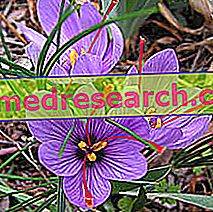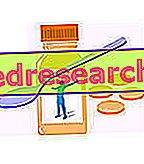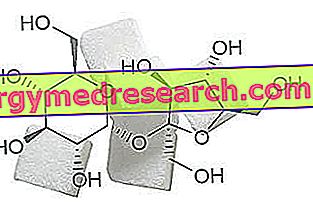
Scientific name
Crocus sativus
Family
Iridaceae
Origin
Asia Minor
Synonyms
Saffron
Used Parts
Drug consisting of stigmas
Chemical constituents
- Glycosides: crocin, picrocrocin;
- Essential oil;
- Dyes;
- Carotenoids;
- Lycopene.
Saffron in Herbal Medicine: Property of Saffron
Saffron is a drug widely used in gastronomy as a dye (see recipes with saffron), but it also has interesting therapeutic properties. In fact, saffron has long been known in folk medicine as eupeptic, sedative and antispasmodic; however, due to its high toxicity at high doses, its use is limited to the kitchen.
Biological activity
Saffron is a plant widely used in the culinary field, to which are attributed interesting properties, among which the digestive ones stand out. In fact, saffron taken in small doses is able to stimulate the secretion of gastric juices, thus favoring digestion.
However, due to the toxicity of this plant (when taken at high doses), its use has not been approved for any therapeutic purpose.
Nevertheless, several studies have been carried out to identify and investigate further saffron properties that could be applicable in the medical field. More specifically, some researches have investigated the potential neuroprotective properties of the aqueous saffron extract and the crocin in it, obtaining encouraging results and proposing a possible use of the aforementioned extract as an adjunct in therapies against neurodegenerative diseases characterized by oxidative stress, such as for example, Parkinson's disease. However - before a medical application of this type can be approved - further research must be carried out.
Moreover, from other studies conducted on saffron, it seems to have emerged its potential slimming activity, exercised through the reduction of appetite and through the increase in the sense of satiety. This has led to the marketing of numerous food supplements based on saffron which boast these alleged slimming properties. However, to confirm the preliminary results obtained to date, further and more in-depth clinical studies should be conducted.
Saffron in folk medicine and homeopathy
Saffron is used in folk medicine to stimulate digestion.
In Chinese medicine, however, it is used in case of menorrhagia, or in the case of amenorrhea. Furthermore, in Indian medicine, saffron is used to treat bronchitis, sore throat, headache, fever and vomiting.
In the homeopathic field, saffron is used for the treatment of epistaxis, dysmenorrhoea, haemorrhagic menstruation and hysteria.
Side effects
Small-dose saffron should not cause any particular problems.
In the event of excessive doses, on the other hand, an overdose may occur characterized by symptoms such as: dizziness, numbness and bleeding due to a reduction in the number of platelets (purpura, enterorrhagia, hematuria), vomiting, intestinal colic, uterine bleeding, sensation of dizziness, yellowing of the skin and mucous membranes and central paralysis.
In the case of saffron overdosage, the administration of activated charcoal or gastric lavage may be useful.
Contraindications
Avoid taking in the event of hypersensitivity to one or more components.
Because of its ability to stimulate uterine contractions - therefore, to exercise an abortive activity - the use of saffron is contraindicated in pregnant women. As a precautionary measure, even mothers who are breast-feeding should avoid taking saffron.
Pharmacological Interactions
- not known.
Warnings
The maximum daily dose of saffron that can be taken is 1.5 g. The abortive dose is 10 g, while the lethal dose of saffron is about 20 g.



